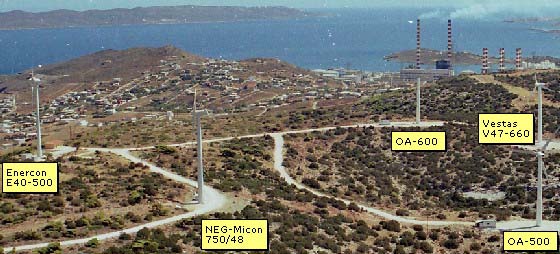 |
| Wind Farm operation |
| · Monthly production charts |
| General Info |
| · CRES Wind Farm |
| · Technical specs of the WTs |
| · Monitoring & control of the wind farm |
· Installation photos |
| · Hydrogen Production |
| · Related articles |
3.01 MW Demonstration Wind Farm
Various
Wind Energy technologies in Complex Terrain topography
Location:
Lavreotiki, SE Attica, Greece

( Photo taken from the 100m high meteo-mast,
situated NNW of the Wind Farm, before the nacelle installation of the
ÏÁ-600 )
On-Line monitoring of the Wind Farm, using a mobile phone:
Send an SMS message with the character ? to +30 6944 560 987 and you will receive instantly the last 10min statitistics of the Wind Farm operation.
A wind-hydrogen experimental plant has been constructed in the wind park of the Centre for Renewable Energy Sources (CRES) in Keratea, Greece, in the frame of the European project "RES2H2" (ENK5-CT-2001-536).
A 25 kW electrolysis unit operating at a pressure of up to 2 MPa is connected to a 500 kW gearless, synchronous, multipole Enercon E40 wind turbine. The electrolysis unit can operate at variable power input, according to the available wind, in a "peak-shaving" mode. Excess energy is fed to the grid. The produced hydrogen is compressed up to 22 MPa in a single stage, and stored in high pressure cylinders. The electrolytic hydrogen may be also stored in six metal hydride tanks with a total capacity of 3.6 kg hydrogen. The utilities comprise an air compressor and drier to supply instrument air to the pneumatic valves, a water boiler to supply hot water to the metal hydride tanks for hydrogen desorption and a water chiller for the cooling water circuit, all supplied by wind energy. The whole system is centrally controlled through a PLC.
The operation of the plant started in October 2005 and is used for experimental purposes, in order to study the performance of the electrolyser, compressor, metal hydride tanks and the overall system.
In late 2008, a PEM fuel cell of 7.5 kW nominal power, supplying up to 6 kW continuous power to the grid has been integrated into the system.